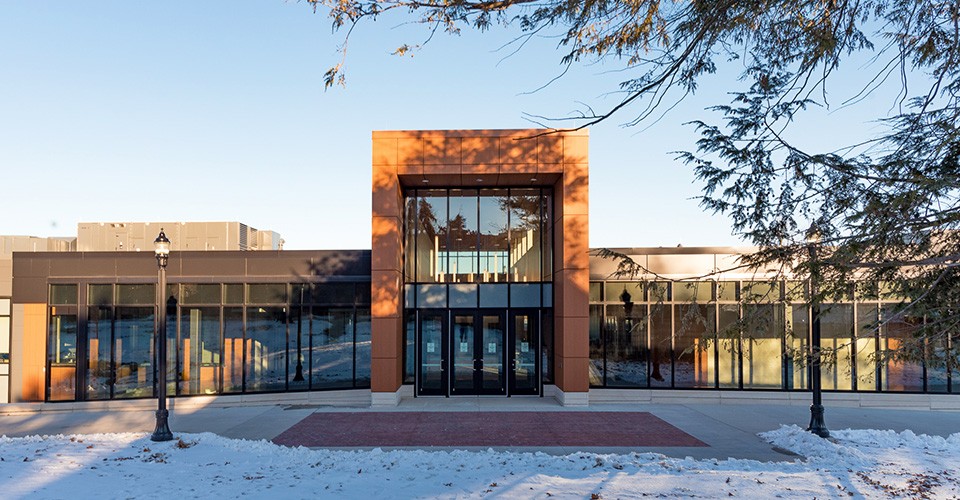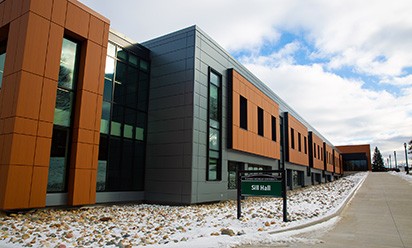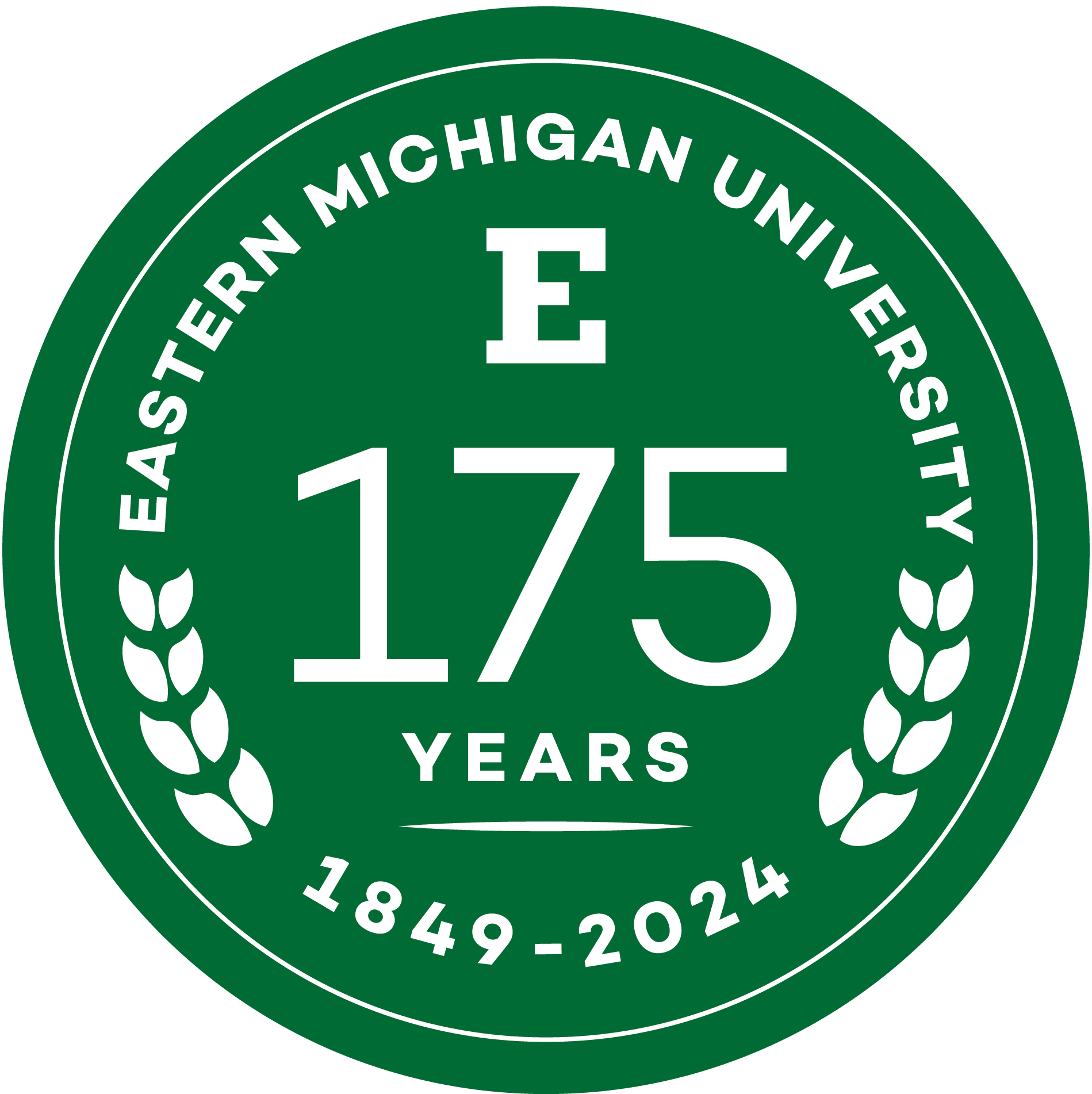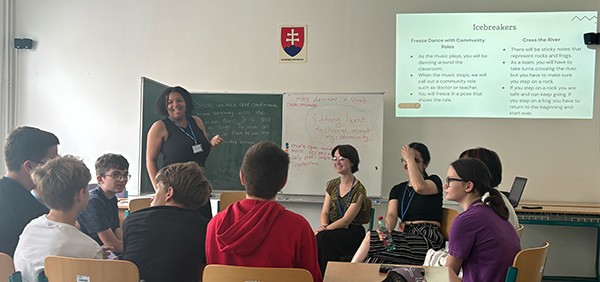Renovated Sill Hall, home of the Eastern Michigan University College of Engineering and Technology, features striking aesthetics along with multiple research labs and flexible maker spaces that enhance learning, research and collaboration

YPSILANTI – A trip to the southeastern end of the Eastern Michigan University campus will never be the same.
Where once stood a hunkered down hulk of a building – the original Sill Hall – students now can experience a striking new, highly functional Sill Hall after a $40 million renovation to accommodate the expansion of engineering programs in the College of Engineering and Technology.
For students and faculty at EMU, Sill’s now quite the thrill.
“It’s fabulous,” says Mohamad Qatu, dean of the College of Engineering and Technology at EMU, during a tour of the building this month.
Indeed, the changes are evident right as you approach Sill. The once bland exterior has been replaced by an attractive, multistory brown façade, welcoming visitors into a striking atrium area flowing with outdoor light and distinct light fixtures.
The old main entrance, in which you were greeted by a stairway leading to a split floor facility with minimal sightlines and confusing navigation, seems a faded memory.
Helping train students for high-demand careers
The dramatic renovation and expansion of the 92,635 square foot structure involved modernizing classrooms and labs, lecture halls, student commons areas and faculty offices.
The renovation has also created flexible use spaces for both research and instruction, along with replacing architectural, structure, mechanical and electrical systems. Sill has also been expanded by 16,000 square feet to support numerous collaborative lab spaces for the engineering programs.

The renovated Sill Hall accommodates two relatively new undergraduate engineering programs – Mechanical Engineering (Fall 2017) and Electrical & Computer Engineering (Fall 2018) – which marked the first engineering programs for the University. In June, 2019, the EMU College of Technology became the College of Engineering and Technology in recognition of that significant growth.
“This spectacular and highly functional facility underscores the University’s strategic and timely emphasis on aligning our academic resources with high growth job areas in the state of Michigan and beyond,” said EMU President James Smith. “The College of Engineering and Technology is focused on an exceptional future. The new Sill Hall will prepare students for fulfilling and highly productive careers in engineering and a wide variety of other disciplines.”
The demand among Michigan employers for more engineers in Michigan is significant. It is estimated our state’s public universities meet less than half of that demand, Dean Qatu notes.
“This facility makes us one of the leading engineering schools in the state,” said Philip Rufe, a professor of engineering and an interim director in the College. “I believe we’re going to become a first choice for many prospective students.”
More important than the aesthetics – excellent sightlines, glassed in classrooms, attractive flooring, spacious halls and comfortable social spaces – renovated Sill is a highly functional and versatile building, a state-of-the-art academic facility where faculty and students can undertake high-level, hands-on research, develop projects and work together as an engineering team.
A variety of special research and learning spaces
A committee that included Dean Qatu, seven CET faculty members, Bob Densic, EMU’s manager of planning and design; and project manager Chris Longerbeam offered input on needed aspects in the renovated facility.
Sill Hall’s special new features include:
Research labs: Sill now offers two engineering research labs, where faculty members can do their own research and collaborate with students. An example is the Electrical Engineering and Computer Engineering lab, where three to four faculty members can work simultaneously. Such a feature is crucial in attracting top-notch faculty, who will directly inquire about the opportunity a facility offers to advance their research, Rufe said.
Mechanical engineering research lab and auto lab: Another distinctly hands-on area, where students can work on engines and machines, do research and learn about automotive computer technology that resists hacking efforts. The lab already benefits from partnerships with companies such as GM and Shell, says mechanical engineering professor Andrew Mansfield, who helps oversee the area.
Robotics lab: Students going into engineering manufacturing will benefit greatly in using one of the five robotic arms in the lab – a key feature of so many plants and production facilities these days.
3D printing lab: The wonders of 3D printing can be seen here, as students will be able to make a variety of key elements of modern life. One example: The facility participated in making COVID PPE for local and regional health care facilities, Rufe noted.
Cyber security server and lab: Along with its regular computer network, Sill has a distinct, separate IT room set up for students in the Cyber Security program. Students can use the facility to learn how users hack into computer systems and how to troubleshoot and thwart hacking efforts.
In addition, the special cyber security lab, loaded with new computers, offers three options for students, all in one classroom. They can experience a live lecture in class, a live lecture via Zoom, or an asynchronous, recorded lecture. Such a three-pronged option broadens enrollment possibilities for students who cannot regularly make it to campus because of work and other demands, Dean Qatu said.
Flexible maker space: Sill offers a variety of these areas, where faculty and students can engage in a variety of projects, based on the room’s versatility. Electrical outlets hang from the ceiling, offering easier maneuvering. The availability of such work areas can help faculty attract grants and enhance collaboration with companies and businesses, Dean Qatu said.
A virtual reality lab: “You truly feel embedded there,” Qatu notes, citing the many uses of virtual reality in training students and professionals in various engineering scenarios. “This facility is an extremely component of the future for many students.”
Auditoriums: The two spacious, remodeled auditoriums offer excellent sound and sightlines, and are capable of hosting a wide variety of large classes, anything from engineering to math to English literature.
“As a professor of education, I taught a class of 125 undergrads, and I would have done anything for a space like this,” said President Smith, viewing the room with an appreciative smile.
In addition to engineering, the college offers a wide variety of distinct programs and areas of study in high-demand career fields. Those include artificial intelligence, autonomous vehicles, aviation, cyber security and information assurance, construction management, drone technology, hotel and restaurant management, interior design, military science and simulation, animation and gaming.
“These are extremely exciting times at the College of Engineering and Technology,” Dean Qatu said. “Our faculty and administration view the new Sill Hall as an outstanding opportunity to recruit students and faculty, to build on existing collaborations with national and international partners, and expand research and funding opportunities, with the ultimate goal of further raising the profile of our graduates and the college.”
For more information about EMU’s College of Engineering and Technology, visit the college’s homepage
About Eastern Michigan University
Founded in 1849, Eastern is the second oldest public university in Michigan. It currently serves more than 16,000 students pursuing undergraduate, graduate, specialist, doctoral and certificate degrees in the arts, sciences and professions. In all, more than 300 majors, minors and concentrations are delivered through the University's Colleges of Arts and Sciences; Business; Education; Engineering and Technology; Health and Human Services; and, its graduate school. EMU is regularly recognized by national publications for its excellence, diversity, and commitment to applied education. For more information about Eastern Michigan University, visit the University's website.
February 10, 2021
Written by:
Geoff Larcom
Media Contact:
Geoff Larcom
glarcom@emich.edu
734-487-4400
More Stories

EMU Honors Crochet and Knitting Club ties the community together through acts of service.

Southeast Michigan Stewardship Coalition at Eastern Michigan University appoints new leadership.




